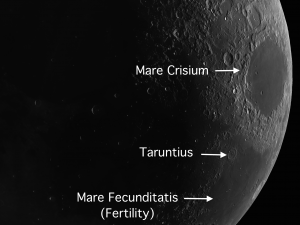The week of May 9-15 takes us from lunar Day 4 through Day 9. This is an ideal window to be observing the Moon. There is a plethora of craters and mountain ranges that stand out in mind-boggling detail! This week we will highlight the crater Taruntius, visible on Tuesday. 
• Taruntius: [NE/J14; L=47°E] Located on the north shore of Fertility, Taruntius is a wonderful example of a floor-fractured crater (FFC). Take a close look at it. Once you are familiar with the appearance of “normal” craters, you will notice right away that Taruntius has an unusually shallow basin. This is because hot magma underneath pushed upward with such force that the entire floor rose a little over a mile to its present level! 
Also notice the surrounding material that was ejected from the impact (the secondary craters) and the small crater Cameron that resulted from an object that hit precisely on the northwest rim. (Although Cameron looks small, it is nearly seven times larger than Meteor Crater in Arizona!) Cameron is a simple crater. Can you tell if it is bowl-shaped or does it have a flat floor?
OF ADDITIONAL INTEREST ON LUNAR DAY 4 THROUGH DAY 9:
On Tuesday (wait until about 9:45 PM in your time zone), the Eskimo Nebula will be just about 4° ENE of the Moon (on a line connecting the Moon and Pollux). It’s a type of dying star called a planetary nebula and will resemble our Sun in about five billion years when it goes through its death throws.
When the Sun runs out of hydrogen fuel, it will start to grow larger and will, in fact, become so large that it will almost fill the orbit of Jupiter! At that point, it will stop expanding and throw off the outer 20% of its atmosphere (which will continue to expand into space and will resemble the Ring Nebula). The bulk of the Sun will then shrink down to the size of the Earth and become a white dwarf — a star so dense that a cubic centimeter of its material will weigh five tons!
The Eskimo Nebula is going through this process right now, but unlike the Ring Nebula, you can see both the ring and the white dwarf!
======================
It is highly recommended that you get a copy of Sky and Telescope’s Field Map of the Moon, the very finest Moon map available for use at the telescope. It is available for $10.95 at www.skyandtelescope.com and on Amazon. All features mentioned in this blog will be keyed to the grid on the Field Map and will look like this: Plato: [NW/D9]
Credits:
Courtesy of Gray Photography of Corpus Christi, Texas
Lunar photos: NASA / USGS / BMDO / LROC / ASU / DLR / LOLA / Moon Globe. Used by permission
- Rupes Cauchy: A Best Known Fault on the Moon - July 22, 2024
- Moon Crater Schickard – Crater Floor has Stripes - July 15, 2024
- Moon Craters Langrenus and Vandelinus - July 8, 2024